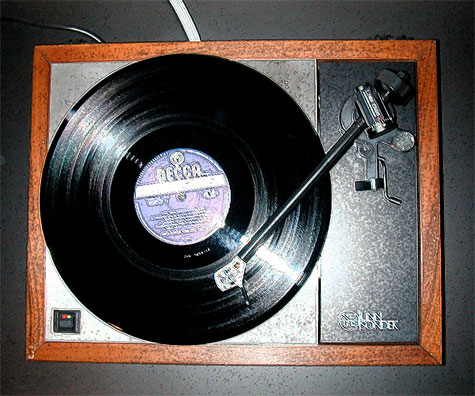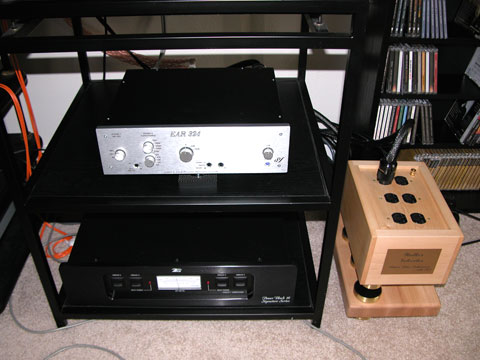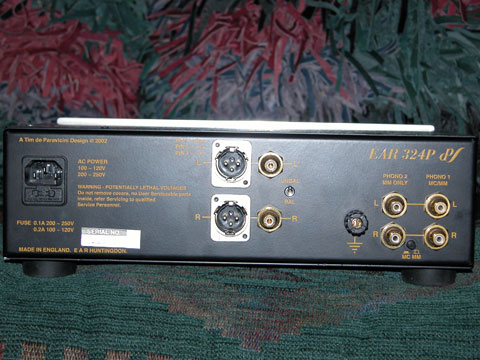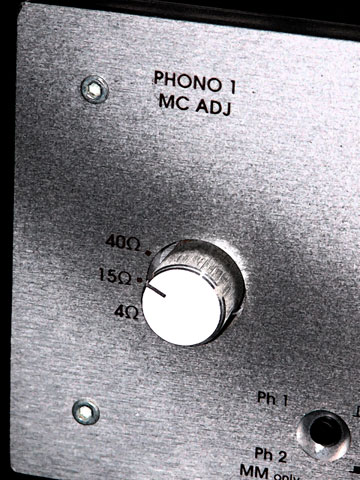You are reading the older HTML site
Positive Feedback ISSUE
15
september/october 2004
e.a.r.
Impressions: The 324 phono preamplifier
as reviewed by David W. Robinson
Photographs and image processing by David W. Robinson
DAVID ROBINSON'S SYSTEM LOUDSPEAKERS ELECTRONICS SOURCES CABLES ACCESSORIES
|

Background to more vinyl hereabouts
I'll say it again, just in case you missed it any of the other times I've said it: LPs ain't near dead, amigo. Despite my long-time love for open-reel, and my new-found (six years now, and growing) love for DSD and SACD (which continues to point to a great future for fine audio), my several thousand LPs are treasured friends that I would not willingly go without. And what vinyl lover would want to be without the polished rituals that go with our albums, turntables, and cartridges? Warts and all (and in the order of things, turntables have them), there's magic there.
Me, I don't care for the "either/or" game when it comes to SACD or vinyl. (CD's are not in that race.) "Both/and" does nicely, since it gives me the best of both worlds, and lets me shift between them according to my mood. Red wine versus white; Cohiba versus Fuente; Porsche 928GT versus Dodge Viper — the correct answer is "both!" (Binary weenies are hereby invited to step to the rear of the bus.)
And because that's true, I've been working very hard over the past three years to bring in interesting new designs on the vinyl side of the ledger, to balance our coverage of DSD and SACD developments. This has been harder than you might think; it was certainly harder than I thought. The logistics of reviewing turntables, tonearms, and cartridges are not trivial. I'll say more on this subject in a later issue, when I discuss the turntables that have started to arrive here at PFO River City, and some of the frustrations I endured to get them here.
The things I do for vinyl…
Then again…
Phono amps have been a different kettle of fish, though. Over the past year I've had several phono amps in for a visit. Manley Labs' terrific Steelhead, our Brutus Award winner for phono amps in 2003, was a very fine piece of work, and left here only with real regrets on my part. What excellent sound! What flexibility! In the Steelhead EveAnna and company put together a thoughtful and full-featured design, exemplary in its ability to give the vinyl lover all sorts of front panel control over the requirements for a given cartridge/tonearm combination.
After the Steelhead left, I returned to my old pal, the Linn Linto, for day-to-day duty with LPs. At its price point, the Linto remains a real stalwart, with no bad habits, ultra-low noise floor, and good gain even with low output MCs. But I missed the Steelhead's level of adjustable performance, and began a search to bring in other phono amps for consideration. Furthermore, with several world-class reference turntables due to arrive over the next year, it was time to upgrade the phono amp section. Which way was I to go?
Then, while I was visiting with the PFO Los Angeles gang last spring for an audio powwow (see PFO Issue 13 at www.positive-feedback.com/Issue13/bbq.htm), I got a chance to visit all too briefly with my good audio friend Dan Meinwald, and hear his vinyl playback system. Dan has exceptional sensibilities, and has dedicated his life to pursuing the possibilities of fine audio, which is a very noble quest that we both share. After listening for a while, I had to admit it: I was very pleased with the wonderful sound that he was getting.
The phono amp that he was using was using? Tim de Paravicini's E.A.R. 324.
What ho! Say no more! Tim de Paravicini is an audio acquaintance of mine, and is truly one of that rare crowd of significant audio designers who is really a master of fine audio. (That often misused word "genius" does come to mind in this connection.) I've heard his work both in the studio (for example, see my article on MoFi's initial launch of DSD and Tim de Paravicini's role in that immensely important project in the PFO archives at www.positive-feedback.com/Issue1/MoFiDSD.htm) and at audio shows, but hadn't heard his work in my listening room since listening to his fine V20 tubed stereo amplifier visited years ago. I asked Dan if he could arrange a review sample of the E.A.R. 324; he was good enough to have the Stereophile folks ship it along to me after they had finished their evaluation.
Shortly thereafter, the 324 arrived, and I dug in.

The E.A.R. 324 phono amp plugged into the Walker Audio Velocitor (the light brown Maple unit to the right) via Silent Source power cabling
The thing itself
The E.A.R. 324 phono amp is a solid-state device weighing in at a hefty 11 pounds, and measuring 12.75" wide x 4.25" high x 10.5" deep. There are two RCA inputs, one dedicated to MM, the other switchable for MM or MC. Two outputs are provided, one for unbalanced, the other for balanced.

Rear view of the E.A.R. 324; inputs are to the right (Phono 1 for MC/MM is far right, while Phono 2 for MM only is one input set over), with the input selector button just under those RCAs. Ground is next over to the left. The two outputs are in the center.
The front of the unit features a number of very helpful controls:

The Phono 1 MC input is front-selectable for 40, 15, or 4 Ohm operation. Phono 2 MM can be set for capacitance at 20, 100, 220, 330 or 470pf; impedance can be dialed in at 15K, 22K, 33K, 47K, or 100K. There is a push button to toggle between Phono 1 and Phono 2. A three-position attenuator allows for 0dB, -6dB, or -12dB levels. A very handy button is supplied to toggle phase, a function that ought to be supplied on every audio playback device, in my opinion. Also very useful is a toggle button for stereo/mono mode, so that you can sum the signal when playing back mono LPs. (Phono amps without this function are annoying.)
There is no remote control (unlike, say, the Aesthetix Rhea phono amp), but the functionality and engineering of the E.A.R. 324 is otherwise unobjectionable. Personally, I don't mind setting preamp controls manually, and am opposed to any complications that might compromise the output of a phono amp.
Overall, I would assess the controls on the E.A.R. 324 to be a fine collection of assets for the serious vinyl user. It doesn't have every feature that the Steelhead has, but then neither do most phono amps…and the E.A.R. 324 is much closer in user-adjustable capability to the standard set by the Steelhead than other phono amps that I am familiar with. If you're used to a "black box" phono amp, then the controls on the 324 are going to make your vinyl life a great deal more fruitful.
The path—the sound
I placed the E.A.R. 324 on the middle shelf of my trusty-rusty Target turntable stand. A threesome of Black Diamond Racing cones served as supports. Power cabling initially was via Silent Source, supplied by Walker Audio; these were later replaced by Omega Mikro's for comparison. (I will review these products as a group separately; the Velocitor/Omega Mikro pairing have proven to be an extremely important step forward for vinyl sound in my system.) The source is my Linn LP-12/Ekos/Akiva/Cirkus turntable with the new Lingo power supply, and plumbed with the new Linn silver reference phono cables. Output cables from the 324 are a pair of JENA Labs Symphony cables running in unbalanced mode to the EMM Labs Switchman-3 preamp. JENA Labs also links us to the brilliant darTZeel NHB-108 solid-state stereo amp, which is power corded with JENA Labs power cable directly plugged to a fully-dedicated 20 amp circuit, and connected to the Kharma Grande Ceramique speakers via Ray Kimber's very fine Kimber Select 3035 (copper plus silver @ 2:1) reference speaker cables.
This particular 324 had come directly from a Stereophile review. I don't know how much time the reviewer had put into using the unit—if he or she loves LPs, I suspect "a lot"—but didn't notice that any break-in was required. As is usual for me after placing a review component, I let it warm up for a day or so, and then began to listen. (As time went by, I didn't notice significant improvements, so can't comment on break-in time. Based on my conversations with Dan, I would guess that the answer is "not much.")
From the very first session with the E.A.R. 324, I was forcibly struck by the superb quality of its playback. The first thing that I listen for in a phono amp is whether or not it is quiet. The micro signal coming from a cartridge needs all the help it can get; it doesn't need a lot of noise getting in the way of dynamic range and clean gain. I've always appreciated the performance of the Linto in this regard…quiet, quiet, quiet. Scott Frankland's MFA MC Ref's phono section got this very right, too, and the Steelhead was excellent, as well. How was the 324?
Right out of the gate, the noise floor was wonderful... absolutely terrific. To get any hiss at all out of the darTZeel/Kharma combo, I had to turn dead inputs up to terrifying, cone-threatening levels that I'd never consider using unless I wanted to blow up my speakers.

I had set the load to 40 Ohms (Linn recommends more than 50, which is not an option on the 324). Attenuation was set to 0dB. According to E.A.R., the 324 will produce approximately 54dB of gain. The perceived gain that the Linn Akiva (0.4 mV output) generated in response via the EMM Labs Switchman-3 was more than enough to fill the room comfortably at moderate amplification levels (45-48 or so on the Switchman-3 controller). Let's just say that driving the system to fulsome volume levels was not a problem at all with the E.A.R. 324/Akiva tandem.
More than that, there seemed to be an immediate synergy between the two. I had previously noticed that the Akiva with its Linn silver reference cable and the new Lingo power supply is definitely more extended and detailed in the upper frequencies than either the Arkiv I or II or the Troika (makes me wonder who's been listening to a lot of DSD over at Linn!) Both the Linto and the Steelhead had confirmed this impression. The E.A.R. 324 ratified my earlier take on where Linn was taking the LP-12 with the Akiva/Lingo II; it's a direction that I like very much.
At the other end of the tonal spectrum, bass frequencies were driven with an excellent combination of presence and control. The Linto is no slouch in this regard, but the E.A.R. 324 seemed to have more of a foundation at the lower end, with a touch more roundness to the lower registers. Strangely, the effect is to make the lower end sound more natural.
The midrange is well balanced, with no disjunctions on transitions to either low or high frequency ranges. The Kharma Grande Ceramiques are quite revealing of nasality and colorations in the mids. The E.A.R. 324 provided a sense of great energy and verve in that realm, without unbalancing the tonal balance of the listening experience. The ability of the LP-12/Ekos/Akiva to produce mids that deliver the goods is no surprise, but the E.A.R. 324 makes a connection with the legendary Linn musicality that was pretty surprising to me. I've been listening to my LP-12 through more than 15 years of upgrades, and the 324 was showing me that there was more in the Akiva/Ekos/Linn silver/Lingo II than I knew via the Linto... or even via the Steelhead, which surprised me more than a little.
The upper ranges were clean, clear and extended, without being forward or sizzling. The Akiva/Linn silver reference phono cable has added noticeably to the LP-12's sense of space and atmosphere, and the 324 pulls that right into place. I have heard some turntable systems that have a tendency to put the higher frequencies in your face, acting almost like bad juju EQ that's slewing that end of the audio spectrum. The E.A.R. 324 sounds spot on, and avoids that forward tilt... not surprising given Tim de Paravicini's well-known attention to audio detail and deep understanding of getting RIAA right. E.A.R.'s web site claims that the 324 seals up the sum of Tim's audio wisdom on the subject of phono amps; given what I'm hearing, I can certainly believe it.
Further, I liked the way that the E.A.R. 324/Linn combo handled soundstaging and imaging. The acid test for me are my best RCA Living Stereo's... Witches' Brew, Respighi's Pines... that sort of thing. The sense of width and depth in my listening room, the placement of performers, and the layering of the orchestras, were not to be faulted. I've listened to my various reference LPs many times over the years, and have a strong interest in letting stereo be stereo. Some commentators say that "imaging" or "soundstaging" are "artifacts of the stereo recording process."
Yes, and your point is... ?
The ability to listen into a stereo recording... to visualize the layout that produced a beloved performance... is to me one of the delights of fine audio. The E.A.R. 324 does a superior job of helping the LP-12 system present the contours of an audio event. The sound is round, full, and brimming with the whisper of presence; the naturalness of the rendition allowed me to relax into my music. From me, this is very high praise.
Dynamics are no problem at all. The combination of the ultra low noise floor and the exceptional gain provided by the E.A.R. 324 meant that range is not an issue. If anything, you may find (as I did) that you're able to turn down the volume a bit with the 324.
My minor wish list
Perfection in audio being unobtainable, there are a few things that I think could be improved on in the E.A.R. 324—and who knows? Maybe Tim will give phono amps another cut or two... so I'll put my list into play.
First, being the greedy and grasping fellow that I am, I could wish that there were three inputs, with two of them being MC ready, like Manley put on the Steelhead. (The Steelhead spoils you; the level of configurability is truly extraordinary.) Failing that, I'd like to see both inputs on the 324 made MC-capable. Many of us who love vinyl and would be interested in the 324 have more than one MC around the place, and would like to be able to shift platforms without having to re-plug RCAs.
Second, the recessed toggle buttons are fairly small, and not easy to operate if one has large fingers. Those who are mighty of phalanges will have to use the eraser end of a pencil or some other harmless device to set these. Third, while I don't use MM myself, and so am unable to comment on the sound or logic of the MM controls of the 324, the front panel layout doesn't make what will happen in one scenario very clear. After some online research, I found that if a user has two MM turntables, the settings of Phono 2 do not govern the operation of the MM on Phono 1—the impedance is "fixed" (see www.ear-yoshino.com/productdetails.asp?page=8&id=40), but the fixed value is not specified.
Finally, I know that some turntable lovers would like to have alternatives to the standard RIAA curve for playback of their more esoteric pressings. Me, I reckon that you can't have everything at this price point... not even the Steelhead does this... so consider this to be a theoretical point.
Apart from these relatively minor observations, I cannot quibble; the E.A.R. 324 goes well beyond most phono amps in its features and capabilities.
Conclusion
I'm sitting here, finishing up this review while listening to Kooper, Bloomfield and Stills roll on MoFi's pressing of Super Session, one of my favorite albums from the days of yore. The music sound bloody wonderful; I find myself being pulled into the listening room again and again, just to bathe in music and memories. The tonal balance is right, the music just flows... it's wonderful! What is it that I'm feeling here?
Then the answer comes to me: with the E.A.R. 324 in play, the Linn LP-12/Ekos/Lingo II/Linn silver sounds more like master tape than I can remember. The LP-12 is usually noted for musicality, and it still has that, for sure... but somehow there's a greater sense of connection and affinity with the underlying tape. The E.A.R. 324 is closer to the heart. It links me to my vinyl by being so fundamentally right in so many ways.
Confirmation of the emotional rightness of the E.A.R. 324 came in an interesting way. When the time came to send the review unit back to Dan Meinwald, I bundled everything up, shipped it off (while feeling some distant, nagging regrets), and then put the Linto back into place. More LPs followed... more listening... a furrow began to appear ‘twixt my brows…
...then within a day or two, I was back on the phone with Dan, telling him to ship the bloody E.A.R. 324 back to me. Blast it all, I would find some way to make payments on the thing... I had to have it! (Give me credit; I didn't whimper too much.) Dan was a good fellow, and arranged to get it back to me directly. And now I am a happier fellow.
So yes, hackneyed as it sounds, I have to say it: "I liked it so much that I bought it." If you think that's simply a cliché—well, it's your loss.
The reader is now forewarned; don't listen to the E.A.R. 324 unless you're prepared to join me and make a buy. As a matter of fact, you shouldn't be surprised if you see the E.A.R. 324 receiving a Brutus Award in just a couple of months; Tim de Paravicini has crafted a flat-out bringer of delight for those of us who treasure our LPs. For me, it was irresistible.
The E.A.R. 324 therefore rates a Ye Olde Editor's "Very Highest Recommendation."
A Post Scriptum to my Review of the E.A.R. 324 Phono Amp
Stop the (virtual) presses! I've learned some important additional technical information from the folks at E.A.R. about the E.A.R. 324 phono amp that I need to pass along to our readers. This will clarify several points that I commented on in my original review.
First of all, in my comments on MC loading in the 324, I took the settings on the Phono 1 input at face value, assuming that they reflected typical resistive impedance values. I was a bit puzzled at the low values (4 Ohms, 15 Ohms, 40 Ohms), but reckoned that the 40 Ohms would handle anything higher than that. Since the Akiva should be loaded at 50 Ohms or greater (my loading over many years with the Linn Troika, Archiv I and II, and the Akiva via the Linto has been 100 Ohms), I set loading to 40 Ohms on the 324. E.A.R. reminded me that the MC values on the 324 are transformer loads, not resistive loads; the 324 uses the sort of brilliant transformers that Tim de Paravicini has developed for his reference preamp, the 812. The MM (Phono 2) has selective resistive and capacitive values.
AR kindly provided the following set of approximate equivalent resistive values for the 324's transformer-based MC input:
| Nominal Transformer Value | Equivalent Resistive Value |
| 40 Ohms | 500 Ohms |
| 15 Ohms | 100 Ohms |
| 4 Ohms | 50 Ohms |
Second, the level of gain provided by the E.A.R. 324 is indeed 54dB for MM, or for high-output MC on Phono 2 (which, it turns out, is allowable... see below). But the gain for on Phono 1 low-output MC ranges up to a very impressive 72dB (approximately), depending on setting and the precise output of a given cartridge.
The third point... one that clarifies the scenario of a user with two MM turntables... is that Phono 1 can used for MM, and that the settings of Phono 2 do not govern the impedance value of Phono 1. As I noted, these are fixed. E.A.R. provided the useful information that the fixed impedance value for MM on Phono 1 is the customary 47K.
Fourth, E.A.R. says that it is possible to use two MC's on the 324, provided that the MC used on Phono 2 is high-output, or low-output with a step-up transformer. (Indeed, E.A.R. makes the MC3 step-up transformer, using the same transformers as in the 324, at a reasonable MSRP of $1195). I should have considered that option when I was thinking about these scenarios—don't know why I didn't!
These are helpful clarifications; thanks to the folks at E.A.R. for passing them along so quickly to me.
324 phono preamplifier
Retail: $3995
Dan
Meinwald
E.A.R. USA
1087 East Ridgewood Street
Long Beach, CA 90807
TEL: 562. 422. 4747
email address:
[email protected]
web address:
www.ear-usa.com
E.A.R. (Tim
de Paravicini's home base)
web address: www.ear-yoshino.com
